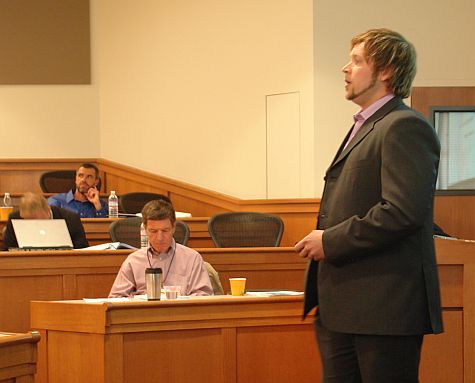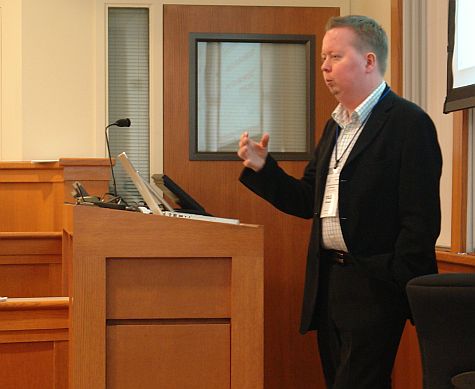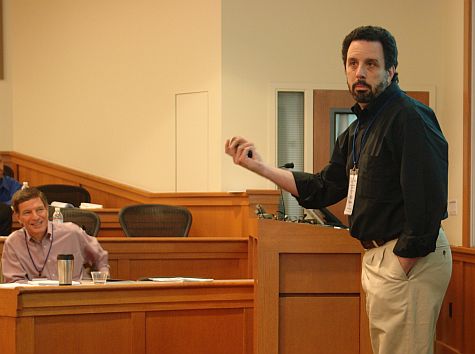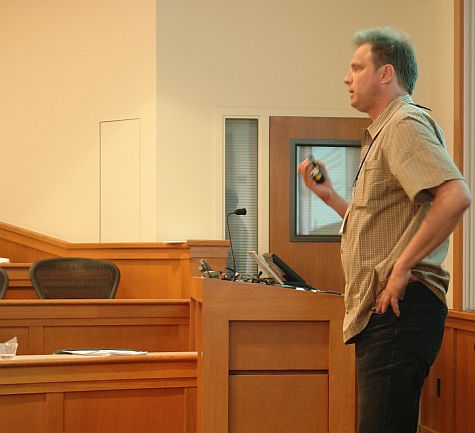This digest was created in real-time during the meeting, based on the speaker's presentation(s) and comments from the audience. The content should not be viewed as an official transcript of the meeting, but only as an interpretation by a single individual. Lapses, grammatical errors, and typing mistakes may not have been corrected. Questions about content should be directed to the originator. The digest has been made available for purposes of scholarship, posted on the Coevolving Innovations web site by David Ing.
Discussant: Antti Ainamo
Papers:
- “eInsurance – Novel Services in the Electronic Environment”, by Ahonen, Salonen, Kivisto-Rahnasto, Jarvinen, and Silius
- “Building SaaS Business on Top of Open Source – Economic and Legal Considerations, by Oksanen, Helander, Seppanen, Puhakka, and Laine
- "Issues in Shifting from a Product-Based Business Model to a Service-Based Model", by Mironov
- “Services Innovation: Sourcing In Lessons from True Professionals”, by Antti Ainamo and Marc Ventresca
Note: (power failure in audio recording)
“eInsurance – Novel Services in the Electronic Environment”, by Ahonen, Salonen, Kivisto-Rahnasto, Jarvinen, and Silius

Tampere
Insurance concept for insurance, to help consumers get more familiar with insurance in an electronic environment
Most electronic use in insurance has been just in getting information
- Surveys show that customers are interested in operating in the environment
Challenges:
- Complex nature
- Transaction frequency low, e.g. compared to banking
- Physical service component is missing
Tekes research project
Focus group results:
- Customers not interested in service, maybe because current service is underdeveloped
Have been doing usability evaluation, compared to British web sites
Practical results for safety and insurance provider
User interface: Drag-and-drop family members into house
Results: "Insurance Selector" service launched by Pohjola Non-life Insurance Company
Feedback that results have been useful
[Questions]
Drop out?
- Insurance isn't high involvement, it's not where people go when they're trying to find something interesting
“Building SaaS Business on Top of Open Source – Economic and Legal Considerations, by Oksanen, Helander, Seppanen, Puhakka, and Laine

Of team, am a lawyer working at SoberIT
How to manage open source in a corporate environment
http://www.coss.fi/ossi
"Community Created Content" book available on web site
What is SaaS (aside from the hype)?
- Chong and Carraro (2006), it's something between a service provider and a customer
- Four levels
- Level 1: ASP, service provider offers online application
- Didn't take off, as not seen a reliable
At the moment moving to Level 4: scalable, configurable, multi-tenant-efficient
- Large server farm
Intellectual property rights: there aren't any, on services
Copyleft
Affero's addition to GPL license
GPL v3
Have created an opensource license checker
[Questions]
Business method patents?
- Don't have business method patents in Europe
"Issues in Shifting from a Product-Based Business Model to a Service-Based Model", by Rich Mironov

Practitioner, consulting to companies that want to move to service models
Software business models:
- Product / licensing model
- Subscription service model
- Transaction service model
Service models force "shared succcess"
Survey, pulse of the market
- http://www.mironov.com/more/survey_results
- If in the product model, still slanted towards large enterprise and government, they're coming up from the bottom of small and medium businesses
- If selling a service, subscription is 33% faster, and nearly 50% faster if selling by transaction models
- How to tell what the users are using? Licensing models mean that transaction logs are at the customer site, but subscription services have transaction logs and 75% of them aren't looking at them
- Service product managers have userids and passwords, but they use product registration cards, so they're not using the data they have
- Almost all companies in Silicon Valley are overdesigning the software, because they guess that users use 50% of available functions
Findings
- SaaS slows down revenues, and increases early capital requirements, because there's a tasting model where they try it, and then might eventually take more
- They don't have people that understand uptime, customer requirements, etc., so they need to change the structure of their firms
Industry metaphors:
- Licensing software firms are grocers
- Service firms are chefs
- Service based pricing (check, please)
- Operational metrics: meat thermometer
[Questions]
Quality is more obvious in SaaS
- Most companies will fail, as they're missing the capabilities
Types
- Different slices
- Will see people tossing out a few critical functions
Why do it?
- New entrants
- People who will lose with new entrants
“Services Innovation: Sourcing In Lessons from True Professionals”, by Antti Ainamo and Marc Ventresca

Why not look at the people who do services only, and don't have anything to do with material products
There's a lot of manufacturing products
Services literature
- More tangible
- Consumption
- Standardized
- Customers in the core
- Absence of inventory
Differences across services, Zeithaml 1981
- High in search qualities
- High in experience qualities
- High in credence qualities, e.g. legal, dental
- Interest in credence offerings
Collected some data in Silicon Valley, Britain and Finland
- Case studies under way
- 1. Service marketing
- 2. Segments
- Medical diagnosis
- Law
- Consulting
- Advertising
- Architecture
- Design
- 3. The sociology of status ordering
Case study: Roschier Wallenius legal services in 1990s
- Legal company, small business, rules that were broken by the leading partner
- Problems and solutions would rise to the partner
- Limited scale
Case: Ideo
- Intra-organizational network, work in small groups, geographically distributed
- They use computers, but that's not the essence of growth
- John Kelly has written books, as a way to diffuse messages
- Douglass North: Until have clearly specified rules, high uncertainty means "personalized exchange" person to person
Services mindset
- Partner is the platform
- Goods and supporting technologies as optional value-added
Partnership model
- Reificiation: serving on a personal basis clients of high importance
- Diffusion (books, mediat atttion) and emergence (problems, solutions)
- Blueprinting (delegating to lower salary)
Implications
- e.g. HP and Nokia or IBM and Nokia have "exclusive" strategic partnerships for different things
- Multiple layers of hierarchies
- Dedicated account managers
[Questions]
New? Ideas of branding
- Target publication wasn't to introduce very new
- Sociology of status, search qualities
Service innovation or service marketing?
- Trying to show organization design for service innovations

This work is licensed under a Creative Commons Attribution-NonCommercial-ShareAlike 4.0 International License